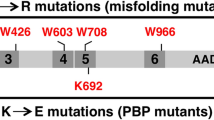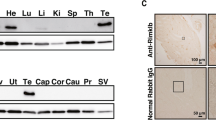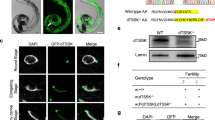Abstract
tr-kit is a truncated form of the tyrosine kinase receptor c-kit expressed in the haploid phase of spermatogenesis. Upon microinjection, tr-kit triggers metaphase-to-anaphase transition in mouse eggs by the sequential activation of Fyn and PLCγ1. Here, we show that tr-kit promotes the interaction of several tyrosine-phosphorylated proteins with the SH3 domain of PLCγ1. Western blot analysis indicates that one of these proteins is Sam68, an RNA-binding protein that is known to interact with and be phosphorylated by Src-like kinases in mitosis. tr-kit promotes the association of Sam68 with PLCγ1 and Fyn in a multimolecular complex, as demonstrated by co-immunoprecipitation of the phosphorylated forms of these proteins using antibodies directed to anyone of the partners of the complex. Expression of tr-kit potentiates the interaction of endogenous Sam68 also with the SH3 domain of Fyn. Furthermore, the subcellular localization of Sam68 is affected by tr-kit through activation of Fyn in live cells. Lastly, we show that interaction with the SH3 domain of Fyn triggers the release of Sam68 from bound RNA. Thus, our data suggest that tr-kit promotes the formation of a multimolecular complex composed of Fyn, PLCγ1 and Sam68, which allows phosphorylation of PLCγ1 by Fyn, and may modulate RNA metabolism.
This is a preview of subscription content, access via your institution
Access options
Subscribe to this journal
Receive 50 print issues and online access
$259.00 per year
only $5.18 per issue
Buy this article
- Purchase on Springer Link
- Instant access to full article PDF
Prices may be subject to local taxes which are calculated during checkout








Similar content being viewed by others
References
Albanesi C, Geremia R, Giorgio M, Dolci S, Sette C and Rossi P . (1996). Development, 122, 1291–1302.
Besmer P, Manova K, Duttlinger R, Huang EJ, Packer A, Gyssler C and Bachvarova RF . (1993). Dev. Suppl., 125–137.
Blume-Jensen P, Jiang G, Hyman R, Lee KF, O'Gorman S and Hunter T . (2000). Nat. Genet., 24, 157–162.
Chen T, Boisvert FM, Bazett-Jones DP and Richard S . (1999). Mol. Biol. Cell., 10, 3015–3033.
Cote J, Boisvert FM, Boulanger MC, Bedford MT and Richard S . (2003). Mol. Biol. Cell., 14, 274–287.
Fusaki N, Iwamatsu A, Iwashima M and Fujisawa J . (1997). J. Biol. Chem., 272, 6214–6219.
Ishidate T, Yoshihara S, Kawasaki Y, Roy BC, Toyoshima K and Akiyama T . (1997). FEBS Lett., 409, 237–241.
Lang V, Semichon M, Michel F, Brossard C, Gary-Gouy H and Bysmuth G . (1999). J. Immunol., 162, 7224–7232.
Lee MH and Schedl T . (2001). Genes Dev., 15, 2408–2420.
Ley SC, Marsh M, Bebbington CR, Proudfoot K and Jordan P . (1994). J. Cell Biol., 125, 639–649.
Li J, Liu Y, Kim BO and He JJ . (2002). J. Virol., 76, 8374–8382.
Liu K, Li L, Nisson PE, Gruber C, Jessee J and Cohen SN . (2000). J. Biol. Chem., 275, 40195–40201.
Matter N, Herrlich P and Konig H . (2002). Nature, 420, 691–695.
Oh B, Hwang SY, McLaughin J, Solter D and Knowles BB . (2000). Development, 127, 3795–3803.
Oneyama C, Nakano H and Sharma SV . (2002). Oncogene, 21, 2037–2050.
Pawson T . (1994). Adv. Cancer Res., 64, 87–110.
Richard S, Yu D, Blumer KJ, Hausladen D, Olszowy MW, Connelly PA and Shaw AS . (1995). Mol. Cell. Biol., 15, 186–197.
Rossi P, Marziali G, Albanesi C, Charlesworth A, Geremia R and Sorrentino V . (1992). Dev. Biol., 152, 203–207.
Runft LL, Jaffe LA and Mehlmann LM . (2002). Dev. Biol., 245, 237–254.
Sette C, Bevilacqua A, Bianchini A, Mangia F, Geremia R and Rossi P . (1997). Development, 124, 2267–2274.
Sette C, Bevilacqua A, Geremia R and Rossi P . (1998). J. Cell Biol., 142, 1063–1074.
Sette C, Paronetto MP, Barchi M, Bevilacqua A, Geremia R and Rossi P . (2002). EMBO J., 21, 5386–5395.
Shen Z, Batzer A, Koehler JA, Polakis P, Schlessinger J, Lydon NB and Moran MF . (1999). Oncogene, 18, 4647–46453.
Sorrentino V, Giorgi M, Geremia R, Besmer P and Rossi P . (1991). Oncogene, 6, 149–151.
Takaoka A, Toyota M, Hinoda Y, Itoh F, Mita H, Kakiuchi H, Adachi M and Imai K . (1997). Cancer Lett., 115, 257–261.
Taylor SJ, Anafi M, Pawson T and Shalloway D . (1995). J. Biol. Chem., 270, 10120–10124.
Taylor SJ and Shalloway D . (1994). Nature, 368, 867–871.
Thomas SM and Brugge JS . (1997). Annu. Rev. Cell Dev. Biol., 13, 513–609.
Toyota M, Hinoda Y, Itoh F, Takaoka A, Imai K and Yachi A . (1994). Cancer Res., 54, 272–275.
Venables JP, Vernet C, Chew SL, Elliott DJ, Cowmeadow RB, Wu J, Cooke HJ, Artzt K and Eperon IC . (1999). Hum. Mol. Genet., 8, 959–969.
Vernet C and Artzt K . (1997). Trends Genet., 13, 479–484.
Wang LL, Richard S and Shaw AS . (1995). J. Biol. Chem., 270, 2010–2013.
Zhang Y, Lu Z, Ku L, Chen Y, Wang H and Feng Y . (2003). EMBO J., 22, 1801–1810.
Acknowledgements
We thank Dr Marco Barchi for preparing some tr-kit expression vectors. This work was supported by grants from the Ministero Italiano Università e Ricerca (MIUR) cofin 2002 and Agenzia Spaziale Italiana (ASI).
Author information
Authors and Affiliations
Corresponding author
Rights and permissions
About this article
Cite this article
Paronetto, M., Venables, J., Elliott, D. et al. tr-kit promotes the formation of a multimolecular complex composed by Fyn, PLCγ1 and Sam68. Oncogene 22, 8707–8715 (2003). https://doi.org/10.1038/sj.onc.1207016
Received:
Revised:
Accepted:
Published:
Issue Date:
DOI: https://doi.org/10.1038/sj.onc.1207016
Keywords
This article is cited by
-
Sam68 is a druggable vulnerability point in cancer stem cells
Cancer and Metastasis Reviews (2023)
-
Tr-KIT/c-KIT ratio in renal cell carcinoma
Molecular Biology Reports (2019)
-
The stem cell factor (SCF)/c-KIT signalling in testis and prostate cancer
Journal of Cell Communication and Signaling (2017)
-
RETRACTED ARTICLE: High expression level and nuclear localization of Sam68 are associated with progression and poor prognosis in colorectal cancer
BMC Gastroenterology (2013)
-
The splicing regulator Sam68 binds to a novel exonic splicing silencer and functions in SMN2 alternative splicing in spinal muscular atrophy
The EMBO Journal (2010)



